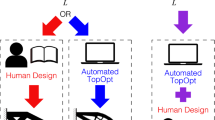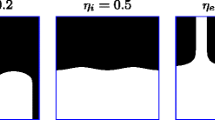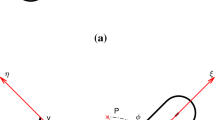Abstract
This work proposes an approach for structural Topology Optimization enforcing geometrical features on optimized designs using a predefined library of geometrical patterns. The approach applies a density-based Topology Optimization subject to a geometrical constraint guiding the design toward shapes matching the geometrical features found in the predefined pattern library. Multiple distance measures and suitable matching algorithms are studied to calculate local mappings between the design in each optimization iteration and the pattern library. An aggregated appearance constraint is evaluating the pattern matching. The gradient of the appearance constraint, objective function, and other constraints are applied in a gradient-based optimization scheme. A parameter for the appearance constraint dictates how closely the design should match the patterns defined in the library. The convergence behavior is studied on a variety of 2D and 3D optimization scenarios. The formulation is also applied to design variables controlling the material orientations alongside the material density as well as other optimization objectives such as stress minimization.












Similar content being viewed by others
References
Barnes C, Shechtman E, Finkelstein A, Goldman DB (2009) PatchMatch: a randomized correspondence algorithm for structural image editing. SIGGRAPH ’09 28(3):24
Barnes C, Zhang FL (2016) A survey of the state-of-the-art in patch-based synthesis. Comput Vis Media 3:3–20
Bendsøe MP, Sigmund O (1999) Material interpolation schemes in topology optimization. Arch Appl Mech 69(9):635–654
Bendsøe MP, Sigmund O (2003) Topology optimization-theory, methods, and applications. Springer, Heidelberg
Bærentzen A, Aanæs H (2002) Generating signed distance fields from triangle meshes. IMM Technical Report
Chen W, Xia X, Xin S, XIA Y, Lefebvre S, Wang W (2016) Synthesis of filigrees for digital fabrication. ACM transactions on graphics, 35(4). Publisher: Association for Computing Machinery
Deng H, Vulimiri PS, To AC (2021) An efficient 146-line 3D sensitivity analysis code of stress-based topology optimization written in MATLAB. Optim Eng 20:1–9
Dumas J, Lu A, Lefebvre S, Wu J, Dick C (2015) By-example synthesis of structurally sound patterns. ACM Trans Graph 34:256
Duysinx P, Bendsøe MP (1998) Topology optimization of continuum structures with local stress constraints. Int J Numer Methods Eng 43(8):1453–1478
Duysinx P, Sigmund O (1998) New developments in handling stress constraints in optimal material distribution. In 7th AIAA/USAF/NASA/ISSMO Symposium on Multidisciplinary Analysis and Optimization. American Institute of Aeronautics and Astronautics
Díaz A, Sigmund O (1995) Checkerboard patterns in layout optimization. Struct Optim 10(1):40–45
Felzenszwalb P, Huttenlocher D (2004) Distance transforms of sampled functions. Theory Comput 8:415–428
Gao X, Ma H (2015) Topology optimization of continuum structures under buckling constraints. Comput Struct 157:142–152
Gumin M (2016) ) Procedural generation from a single example with Wave Function Collapse Algorithm. Springer, Cham
Hoffarth M, Gerzen N, Pedersen C (2017) ALM overhang constraint in topology optimization for industrial applications. In 12th World Congress on Structural and Multidisciplinary Optimisation
Kimmel R, Kiryati N, Bruckstein AM (1996) Sub-pixel distance maps and weighted distance transforms. J Math Imaging Vis 6(2):223–233
Kwatra V, Essa I, Bobick A, Kwatra N (2005) Texture optimization for example-based synthesis. ACM Trans Graph 24:795–802
Langelaar M (2016) Topology optimization of 3D self-supporting structures for additive manufacturing. Addit Manuf 12:60–70
Langelaar M (2017) An additive manufacturing filter for topology optimization of print-ready designs. Struct Multidisc Optim 55(3):871–883
Lee E, James K, Martins J (2011) Stress-constrained topology optimization with design-dependent loading. Struct Multidisc Optim 46(5):647–661
Martínez J, Dumas J, Lefebvre S, Wei L-Y (2015) Structure and appearance optimization for controllable shape design. ACM transactions on graphics, 34(6):12. Publisher: Association for Computing Machinery
Panareda Busto P, Eisenacher C, Lefebvre S, Stamminger M (2010) Instant texture synthesis by numbers. In Proceedings of the vision, modeling, and visualization workshop 2010, vol 2010, pp 81–85
Schmidt M-P, Couret L, Gout C, Pedersen CBW (2020) Structural topology optimization with smoothly varying fiber orientations. Struct Multidisc Optim 62(6):3105–3126
Sigmund O (1997) On the design of compliant mechanisms using topology optimization. Mech Struct Mach, 25(4):493–524. Publisher: Taylor & Francis
Stava O, Vanek J, Benes B, Carr N, Mech R (2012) Stress relief: improving structural strength of 3D printable objects. ACM Trans Graph 31:48:1-48:11
Svanberg K (1987) The method of moving asymptotes: a new method for structural optimization. Int J Numer Methods Eng 24(2):359–373
Vulimiri PS, Deng H, Dugast F, Zhang X, To AC (2021) integrating geometric data into topology optimization via neural style transfer. Materials, 14(16):4551. Number: 16 Publisher: Multidisciplinary Digital Publishing Institute
Wei L-Y, Lefebvre S, Kwatra V, Turk G (2009) State of the art in example-based texture synthesis. Eurographics 2009 - State of the Art Reports. Publisher: The Eurographics Association
Wu J, Aage N, Westermann R, Sigmund O (2016) Infill optimization for additive manufacturing-approaching bone-like porous structures. IEEE Trans Vis Comput Graph 24:1127–1140
Wu J, Sigmund O, Groen JP (2021) Topology optimization of multi-scale structures: a review. Struct Multidisc Optim 63:1455–1480
Acknowledgements
Ole Sigmund would like to acknowledge the support of the Villum Foundation, Denmark through the Villum Investigator Project InnoTop. All authors acknowledge the reviewers for their comments helping to improve the manuscript.
Author information
Authors and Affiliations
Corresponding author
Ethics declarations
Conflict of interest
On behalf of all authors, the corresponding author states that there is no conflict of interest.
Replication of results
Unless explicitly stated in the text, all results presented in this work apply the same default parameters: \(p= 3\), \(Y_{min}= 10^{-6}\), \(Y_0= 1\). We use a density filter of radius 1.5 relative to the element size in regular 2D or 3D grid meshes consisting of squares or cubes, respectively. The patch dimensions are \(l_{x}= 8\), \(l_{y}= 8,\) and \(l_{z}= 8\) in 3D cases and \(l_{x}= 0\), \(l_{y}= 8,\) and \(l_{z}= 8\) in 2D cases. All results are obtained in our C++ Topology Optimization prototyping framework with a dependency on the open-source Eigen library for solving linear systems of equations, although any other similar linear algebra library would be equally suitable.
Additional information
Responsible Editor: Shikui Chen
Publisher's Note
Springer Nature remains neutral with regard to jurisdictional claims in published maps and institutional affiliations.
Rights and permissions
About this article
Cite this article
Navez, T., Schmidt, MP., Sigmund, O. et al. Topology optimization guided by a geometrical pattern library. Struct Multidisc Optim 65, 108 (2022). https://doi.org/10.1007/s00158-022-03197-x
Received:
Revised:
Accepted:
Published:
DOI: https://doi.org/10.1007/s00158-022-03197-x




